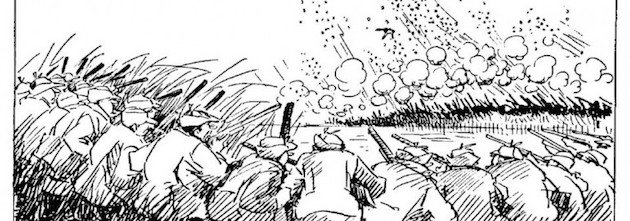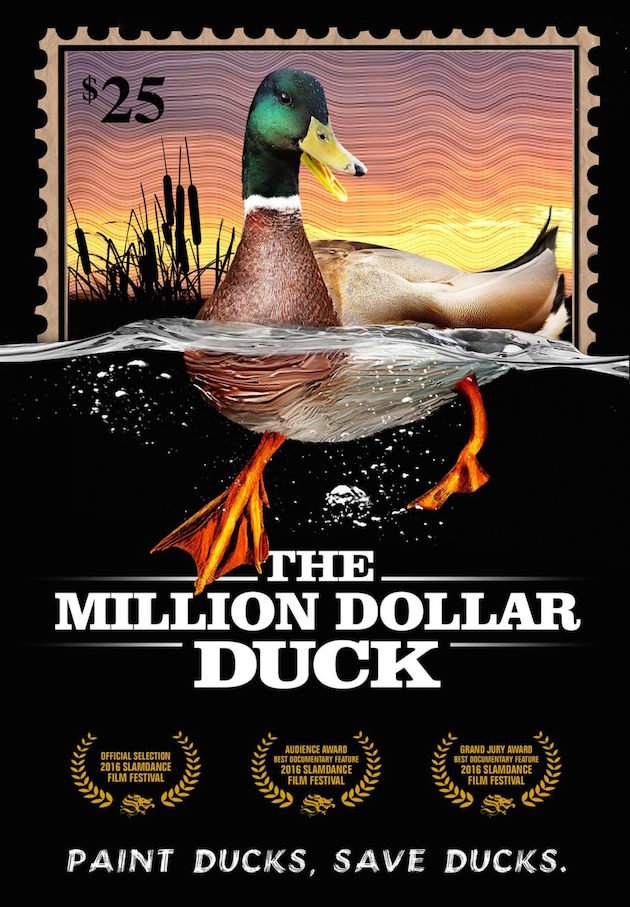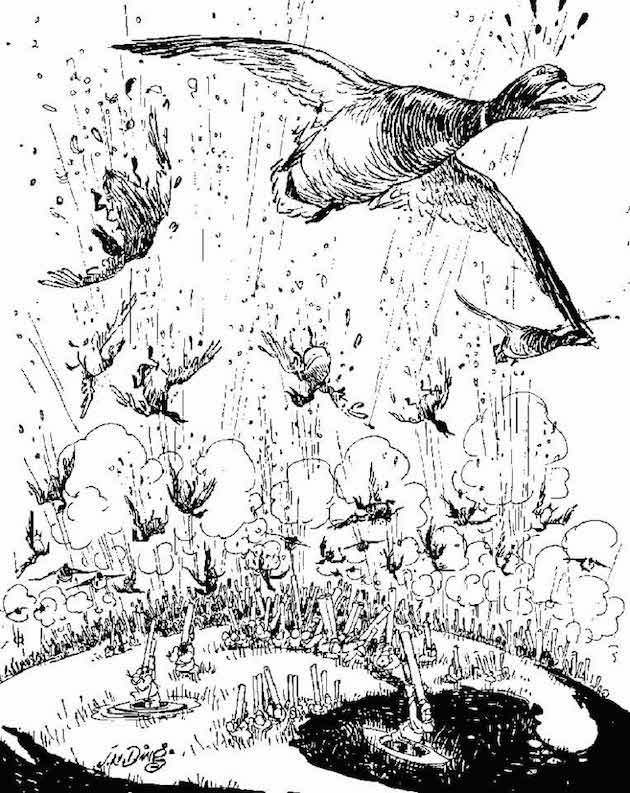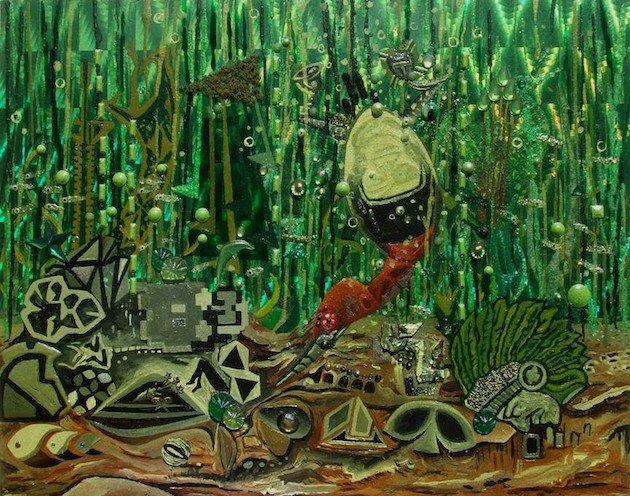As a birder, this 72 minute documentary film about the Duck Stamp Contest didn’t accomplish what I was hoping it might – get people excited about the Duck Stamp, or at least wildlife conservation. It did neither.
The film began with a very brief history of the stamp, which is probably not well know by most casual observers. An explanation is given about how market hunters and the draining of wetlands left no place for migrating waterfowl to land or feed and “the Great Plains soon became a mass graveyard for migratory birds, raising the question, how do we protect birds from man?” Cartoon images by Ding Darling.

In the early years of the newly created 1934 Duck Stamp Act, the stamps were designed by commissioned artists, but in the 1940’s the selection process was opened up to the public in the form of a nationwide contest – the Duck Stamp Contest.
The film follows several contestants on their journey to win what is described as the “Olympics of Wildlife Art.” Contradictory to the naming of the film, the winner of the prestigious contest is offered no outright monetary reward, however that artist may make hundreds of thousands of dollars selling prints and other depictions of his or her artwork.

One of the scenes in the film I found very disturbing as both a birder and wildlife photographer, depicted Adam Grimm and Tim Taylor out in the field attempting to capture images of ducks as reference images for their artwork. As Adam donned his ghillie suit (a camouflage outfit used for concealment), Tim intentionally runs toward the ducks from the opposite side of the pond, yelling and throwing his arms up, forcing the ducks to take flight to drive them toward the waiting photographer.
This is in direct conflict of the American Birding Association’s first Principal of Birding Ethics which is “to avoid stressing birds or exposing them to danger, exercise restraint and caution during observation, photography, sound recording, or filming.”
Their disregard for the welfare of the wildlife they purport to regard so highly also flies in the face of the North American Nature Photography Association’s Principles of Ethical Field Practices which states, “do not distress wildlife or their habitat. Respect the routine needs of animals.”

In my opinion, two of the artists that saved the film were Dee Dee Murry and Bob McBroom. Dee Dee and her dog Hallie are introduced as competing artists. Dee Dee is trying her best to come up with a winning Duck Stamp painting, while her talented blind dog Hallie outsells her own artwork!
Bob McBroom is a thirteen year Duck Stamp Contest entrant who has yet to create artwork that will make it through the initial day of judging. Some folks claim he is mocking the contest with his non-compliant artwork like this depiction of a diving Canvasback. Personally, I think it’s inspirational.

That being said, in preparation of opening day judging of the Duck Stamp Contest, the judges were informed of the contest rules. The entries are judged on three concepts:
- Anatomical accuracy
- Artistic composition
- Suitability to be published on a stamp
With these three ideas in mind, it is easy to see why his work never gets chosen. Oddly enough, my impression of Bob was not that he was mocking the contest but trying to get more people excited about it.
The final third of the movie depicts the arduous live-judged elimination rounds zeroing in on several of the contestants in the hall as they watch their paintings get shot down. One short clip features Ron Louque, the 2002 contest winner chuckling, “only a fool would go there expecting to win the contest!”
The last few minutes of the film were focused on the stamp program and concerns for its future. I thought this comment from Bob McBroom was especially poignant:
The stamp is in trouble I think the same way that a lot of national and state wildlife refuges are. People just don’t go out the way they used to. Hunters are not doing it as much any more. Hunters are slowly declining and generally, that’s the people that buy the stamp. The Duck Stamp program is kinda screwed unless they can get it into the cultural milieu as it were, because there is too many things competing for its attention.
The Migratory Bird Hunting and Conservation Stamp is obviously a successful wildlife conservation program. The problem is that not enough people buy the stamp. Although I applaud Brian Golden Davis for bringing this important issue into the spotlight, I’m not sure this film about the Duck Stamp Contest will help the decline in stamp sales.













Larry, I read your review of the film “The Million Dollar Duck”. Thank you for taking the time to write about it. I wanted to address a couple of your points. First, I think that the film WILL get people more excited/interested in duck stamps and wildlife conservation. Especially when they learn about the program and see the number of passionate people who are involved. Passion is infectious.
Second, I agree with you about the footage of Tim. I was disapointed it made it into the film and I had even talked with the film director about not including it because it isn’t accurate. I guess that the humor the director felt it added won out in the end.
When Tim and I go photographing, Tim (because he can’t afford a quality expensive telephoto lens) walks around photographing habitat reference while I remain stationary tucked in some grasses in a ghillie suit. At the end of the photography trip, I give Tim access to my close up bird photos (that he couldn’t get) and he gives me access to his habitat reference photos that I can’t get with my big lens while I’m tucked in the grass. So it’s sort of a symbiotic friendship.
In relaying this to the film director, Tim mentioned how his walking around taking habitat photos also helps to “rustle” the birds, moving them around so that they’re not just sitting in one place. No doubt walking around wetland areas is going to move birds around… and it does help to get birds to possibly work in close to where I am hiding. He said how sometimes when he crests a hill, whole flocks of birds might take flight at the sight of him.
The director upon hearing this, envisioned a shot of Tim cresting a hill with the birds getting up, but he really wanted to play up the bird “rustling” thing because he found it humerous. Tim was instructed once the cameras were rolling to run up and get the birds to take flight (in a funny way). That’s why you see Tim “acting” so silly in the shot. Neither Tim nor the director were aware that they were doing anything wrong (ethically) in the shot because they weren’t physically harming any birds. It wasn’t until after they were done filming for the day that I even found out about it and spoke with them about it.
I can tell you that footage was shot for the film and does not accurately portray Tim’s behavior in the field. Tim is a huge animal lover and if he felt he was really harming the birds in any way, he wouldn’t have gone along with it. He recently told me about rushing a chipmunk to the vet clinic he hit with his car to try and save it.
The one thing that would most certainly save the Federal Duck Stamp Program is if birders would step up to the plate and buy the stamp.
Adam, thank you for your comment. Speaking as a birder and conservationist, I must disagree with your assessment. I don’t believe that because people are passionate about the Duck Stamp Contest that it necessarily follows they are passionate about wildlife conservation. It appears to me that the two main groups concerned with the Duck Stamp Contest and the actual image on the stamp are the artists themselves and stamp collectors. Anyone truly concerned about wildlife conservation and our National Wildlife Refuges would purchase the stamp, or its alternative, no matter the actual image on the stamp itself.
You state “the one thing that would most certainly save the Federal Duck Stamp Program is if birders would step up to the plate and buy the stamp.” Birders contribute to a plethora of conservation organizations, in the US and around the world. To say that we need to “step up to the plate” is disingenuous at best and probably insulting to many.
The issue whether or not to purchase the Duck Stamp, for most birders, is a matter of conscience. After all, the Duck Stamp is actually a hunting license. Required by waterfowl hunters to “take” waterfowl. Understandably, wildlife watchers witnessing ducks and geese being blown out of the sky with shotgun blasts are not easily persuaded to purchase the stamp.
Suffice it to say that for this reason and myriad others, the suggestion by several respondents to the USFWS proposed changes to the Federal Migratory Bird Hunting and Conservation Stamp Contest regulations was to create an additional revenue stream from another funding tool. We agree with this assessment. That is why we are proposing a Wildlife Conservation Pass. A way for non-consumptive users of our National Wildlife Refuges to proudly support wildlife conservation and refuge enhancement.